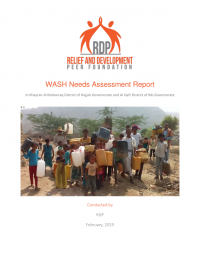WASH Needs Assessment Report in Khayran Al Muharraq District of Hajjah Governorate and Al Qafr District of Ibb Governorate (February 2019)
1. Executive Summary
This needs assessment was designed to be impartial, unbiased, comprehensive, context-sensitive, timely, and up-to-date. It provides sound evidence based on the existing WASH situation in both Khairan Al Moharraq district of Hajjah Governorate and Al Qafr district of Ibb Governorate in order to plan and prioritize the needs and adopt the appropriate and suitable methodology of intervention.
RDP conducted this WASH needs assessment from Jan 29th to Feb 12th, 2019 in the two districts aiming to define and determine the WASH needs by providing in-depth WASH operational information, statistical data about the WASH needs, and preferences of the affected community in these two high priority districts. The needs assessment was conducted according to the WASH cluster technical guidelines for OCHA 1st SA 2019 as illustrated in the methodology and approach section.
Khayran Al Muharraq district of Hajjah Governorate is one among the 122 WASH cluster focus districts as well as among the 193 food insecure districts. This district was classified as IPC phase 4 where 57.5% of the population; 77,000 individuals (HC and IDPs) are in IPC 4 and 5. The sample included a total number of 187 HHs interviews in five sub-districts (Ad Dane’e, Bani Hamla, Sharqi Al Khamesayn, Gharbi Al Khamesayn, and Masrooh) of Khayran Al Muharraq.
Al Qafr district of Ibb Governorate is one among the 122 WASH cluster focus districts as well as among the 230 health cluster focus districts. The district was classified as IPC phase 4 and 5 where 52.5% of the population; 77,000 individuals (HC and IDPs) are in IPC phase 4 and 5. The sample included a total number of 223 HHs interviews in 15 sub-districts (Al Karaba, An Nakhla, Bani Joma’ah, Bani Sawi, Bani Saba, Bani Saif Al Ali, Bani Saif As Safil, Bani Omar Al-Safil, Bani Omar Al-Eali, Bani Mubarez, Bani Margham, Bani Muslim, Bani Mahdi, Hemyar, and Madhagayn) of Al Qafr.
According to the last smart survey of Nutrition Cluster, the SAM rate in Khayran Al Muharraq was 3.3% and 2.7% in Al Qafr district with an estimated number of 937 SAM cases of children 6-59 months in Khayran Al Muharraq and 636 SAM cases in Al Qafr district.
Community acceptance was captured from the FGDs and KIIs data which was directly fed into the findings and recommendations of the NA to ensure accountability to affected population.
RDP has deployed two teams of field enumerators for the NA in the two districts which were trained andled by RDP WASH engineers, 10 enumerators in Khayran Al Muharraq (5 male and 5 female) and 12 enumerators in Al Qafr (7 male and 5 female) to conduct the FGDs and HHs interviews using Kobo Collect forms monitored by GPS coordinates to ensure the reliability of data and visualize the figures on the map. The team leaders conducted the KIIs, water sources assessment visits, and general information of each sub-district.
The comprehensive WASH NA included HHs interviews, Key Informants Interviews, Focus Group Discussions, and General Situation information collection using the WASH cluster tools and RDP customized tools. The famine risk factors were included in the sampling where health and nutrition factors were assessed and samples of HHs with SAM cases were interviewed. The sample covered high land and low land areas considering the geographical factors. Water sources were identified and mapped as a baseline and to consider further assessment during the intervention.


